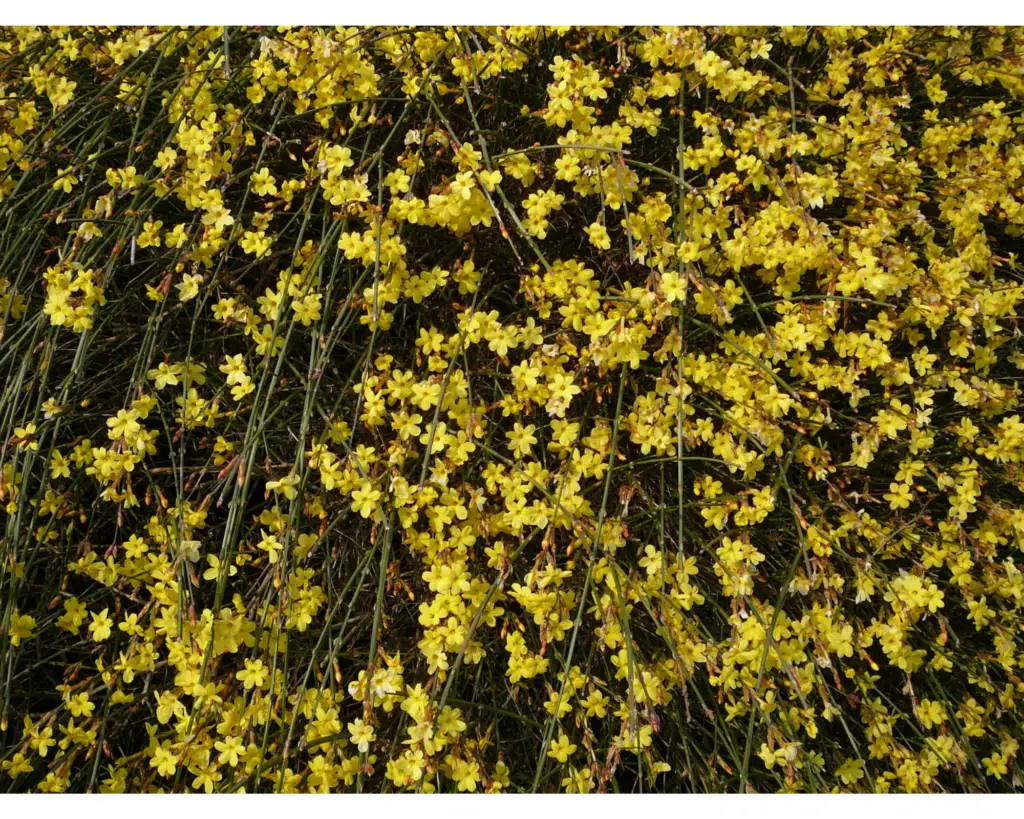Winter jasmine (Jasminum nudiflorum) is a hardy, deciduous shrub native to China. It is one of the most popular winter-flowering plants that can be grown indoors as a houseplant. The plant is known for its bright yellow flowers that bloom in late winter or early spring, providing a burst of colour during the cold and dreary winter months. Winter jasmine is a relatively easy plant to care for, making it an excellent choice for novice gardeners and experienced horticulturists alike. In this article, we will discuss everything you need to know about growing Winter jasmine as a houseplant.
Table of Contents
Appearance
Winter jasmine is a low-growing, sprawling shrub that can grow up to six feet tall (1.8 metres) and eight feet wide (2.4 metres) when grown in the ground. However, when grown as a houseplant, it usually remains smaller, reaching only two to three feet tall (under 1 metre) and three to four feet wide (1 – 1.4 metres). The plant has green, arching stems that become woody as they age, and are covered with tiny, dark green leaves. The leaves are small, oval-shaped, and pointed, and they are typically about one inch long.
The most striking feature of Winter jasmine is its bright yellow flowers. The flowers are small, star-shaped, and appear in clusters at the end of the stems. They have five petals, and each petal is about 1/4 inch long (1 centimetre). The flowers usually appear in late winter or early spring, although the exact timing depends on the climate and growing conditions.


Growing Conditions
Winter jasmine is a relatively hardy plant that can survive in a wide range of growing conditions. It prefers full sun to partial shade, but can also grow in shaded areas. The plant can tolerate a wide range of soil types, but prefers well-drained soil that is rich in organic matter. It is also tolerant of drought and can survive for short periods without water.
When grown as a houseplant, Winter jasmine should be placed in a bright, sunny location that receives at least six hours of direct sunlight per day. It can also be grown under artificial lights, such as fluorescent or LED grow lights. The plant prefers temperatures between 50 and 75 degrees Fahrenheit (10 and 23 degrees Celsius), but can tolerate temperatures as low as 40 degrees (4 degrees Celsius) and as high as 90 degrees (32 degrees Celsius).
Watering
Winter jasmine should be watered regularly, but not over-watered. The plant prefers to be kept moist, but not wet, and it is important to allow the soil to dry out slightly between watering. Over-watering can lead to root rot, which can be fatal to the plant. When watering, it is important to water the soil around the base of the plant rather than the leaves. Watering the leaves can lead to fungal diseases and can also wash away the pollen from the flowers. The plant should be watered more frequently during the growing season, and less frequently during the dormant season.
Fertilising
Winter jasmine should be fertilised regularly to promote healthy growth and flowering. The plant can be fertilised with a balanced, water-soluble fertiliser every two weeks during the growing season. During the dormant season, the plant should be fertilised less frequently, about once a month.
Pruning
Winter jasmine requires regular pruning to keep it looking neat and tidy. The plant can be pruned in early spring, after the flowers have faded. Pruning should be done before new growth begins, as this will encourage the plant to produce new growth in the spring. The plant should be pruned to remove any dead or damaged wood, as well as any crossing branches or branches that are growing too close together. The plant can also be pruned to shape it, although this is not necessary.


Propagation
Winter jasmine can be propagated by taking stem cuttings in the summer. The cuttings should be taken from new growth that is still green and has not yet become woody. Cuttings should be about six inches long and should have at least two sets of leaves. The bottom leaves should be removed, leaving only the top set.
The cuttings should be dipped in rooting hormone and then planted in a well-draining potting mix. The potting mix should be kept moist but not wet, and the cuttings should be kept in a warm, humid environment, such as a propagator or covered with a plastic bag. After a few weeks, the cuttings should begin to produce roots, and they can then be potted up into individual pots.
Pests and Diseases
Winter jasmine is relatively pest and disease-resistant, but it can still be affected by a few common issues. The most common pests are aphids and spider mites, which can be controlled with insecticidal soap or neem oil. Fungal diseases can also occur, particularly if the plant is overwatered or if the leaves are constantly wet. To prevent fungal diseases, the plant should be watered at the base and not the leaves, and any dead or diseased wood should be removed promptly.
Conclusion
Winter jasmine is a beautiful and easy-to-care-for houseplant that provides a burst of colour during the winter months. With its bright yellow flowers and hardy nature, it is a great choice for novice and experienced gardeners alike. By providing the plant with the right growing conditions, watering and fertilising it properly, and pruning it regularly, you can enjoy this stunning plant for years to come.
